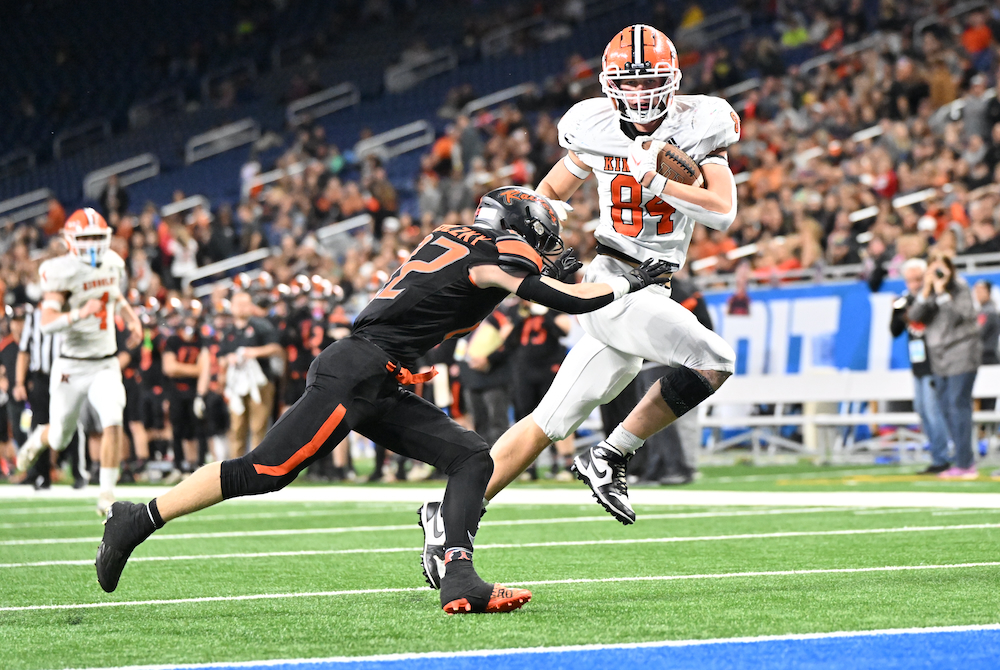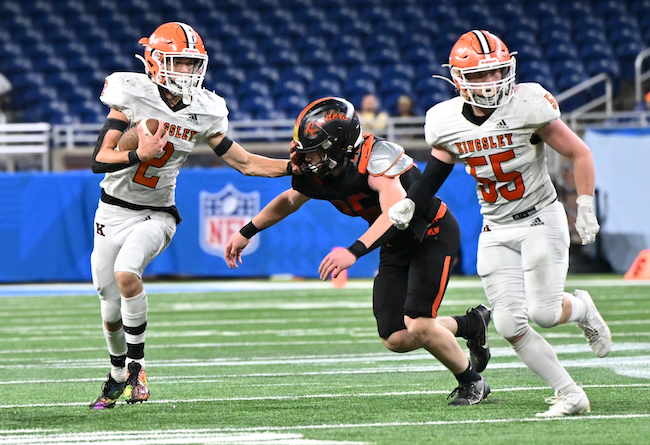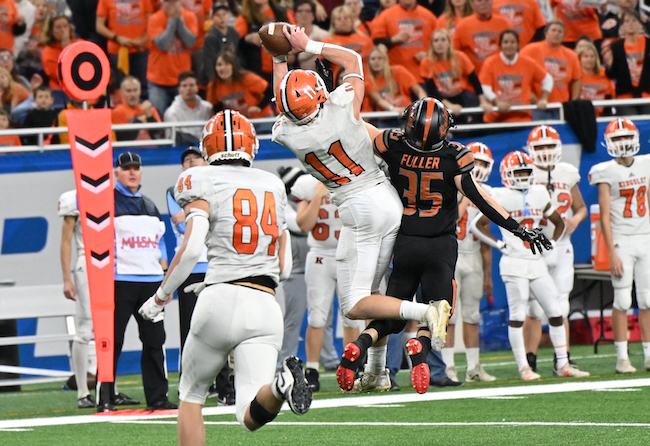
Inside Selection Sunday: Mapnalysis '13
October 28, 2013
By Geoff Kimmerly
Second Half editor
At the end of the day – Sunday, in this case – the 2013 MHSAA football playoff field was determined based on a set of numbers we began working with long before the first kickoff of this season.
So to kick off our discussion of how some of the 2013 playoff-selection decisions were made, here are a few numbers that might boggle the mind – or at least surprise:
- A total of 3,111 high school results were used in determining this season’s field – 2,978 for 11-player and 133 for 8-player games.
- We inputted and then followed the schedules for 623 MHSAA teams.
- We also inputted and followed weekly the schedules for 50 teams from surrounding states and Ontario that played at least one game against one of our MHSAA schools.
- We worked through complicated maneuverings made necessary by seven teams playing a mix of 11 and 8-player games, plus two more teams that played a mix of varsity and junior varsity opponents.
- And by Sunday morning we ended up with a few more numeric rarities: only 225 automatic qualifiers, the fewest since the current playoff system was introduced in 1999, and also an uneven number of at-large bids from our four classes because only six Class D teams reached the number of victories needed to be considered. (This was balanced by taking more at-large qualifiers from Classes A, B and C.)
And that was just the start of one of our most exciting days of the school year.
Following are more details. First, I explain some of the history of the MHSAA playoffs – I’ve lifted this in part from our 2012 report, so skip ahead if you’ve already got that down. Next, I touch on five themes that emerged as we built the brackets for this season’s tournament.
The process
Our past: The MHSAA playoff structure – with 256 teams in eight divisions, and six wins equaling an automatic berth (or five wins for teams playing eight or fewer games) – debuted in 1999, as mentioned above. An 8-player tournament was added in 2011, resulting in nine champions total when November is done.
That’s a long way from our start. The first playoffs were conducted in 1975 with four champions. Four more football classes were added in 1990 for a total of eight champions each fall. Through 1998, only 128 teams made the postseason, based on their playoff point averages within regions (four for each class) that were drawn before the beginning of the season. The drawing of Districts and Regions after the end of the regular season did not begin until the most recent playoff expansion.
In early years of the current process (or until the middle of the last decade), lines were drawn by hand. Dots representing qualifying schools were pasted on maps, one map for each division, and those maps were then covered by plastic sheets. Districts and Regionals literally were drawn with dry-erase markers.
Our present: After a late Saturday night tracking scores, we file in as the sun rises Sunday morning for a final round of gathering results we may still need (which can include making a few early a.m. calls to athletic directors). Then comes re-checking and triple-checking of enrollments, what schools played in co-ops, some records and more before the numbers are crunched and the fields are set.
Those 256 11-player teams are then split into eight equal divisions based on enrollment, and their locations are marked on digital maps that are projected on wall-size screens and then discussed by nearly half of the MHSAA staff plus a representative from the Michigan High School Football Coaches Association. Only the locations themselves are marked (by yellow dots) – not records, playoff point averages or names of the schools or towns. In fact, mentions of those are strictly prohibited. Records and playoff points are not part of the criteria. Matchups, rivalries, previous playoff pairings, etc. also DO NOT come into play. The same process is followed for organizing the 8-player bracket.
Observations and answers: 2013
This doesn’t happen overnight: Preparation for selecting the MHSAA playoff field begins long before the first kickoff of fall, much less the first practice. We load schedules for all 600-plus varsity teams during the summer, and many schedules remain fluid right up until the first Friday of the season – and this fall, a few weren’t settled until Week 2 or 3.
This summer as in some past we also worked through schools closing (Inkster, Saginaw Buena Vista, Detroit Northwestern, Flint Northern), and others deciding in mid-July and early August they would not field teams because of a lack of players.
Sometimes we have to take odd paths to find scores for these games. The last 11-player score to be added to our data this regular season came in as a result of tweeting the sports anchor of a Wheeling, W.Va., television station. Our last 8-player score came in via email from a Wisconsin athletic director at 10:30 Saturday night. Thankfully, we get plenty of assistance from some of our friends in the field, who keep an eye on the data and alert us when something appears missing or incorrect.
Win and advance: This season’s list of 5-4 teams includes a number of heavy hitters that did not receive at-large bids – East Grand Rapids, Utica Eisenhower, Orchard Lake St. Mary’s and Flint Powers Catholic to name a few. All were solid teams and played strong competition. All missing the playoffs likely raised some eyebrows.
But we have to take a look at this from a statewide view. There admittedly can be some argument about what schools qualified for the 226-256 spots in the field – but the important part is that 225 qualified because they all met the minimum win requirement. A playoff is simply that – it decides a champion based on teams winning. For some it’s harder to pile wins, of course, because they play in tough leagues. But the winners of those leagues are in the field – and surely will credit that tough road with getting them prepared to now play the state’s best.
Geography rules: This long has been rule number one for drawing MHSAA brackets in any sport, and is a repeat as well for those who have read this report the last two Octobers. Travel distance and ease DO come into play. Jumping on a major highway clearly is easier than driving across county-wide back roads, and that’s taken into consideration.
Also, remember there’s only one Mackinac Bridge and hence only one way to cross between peninsulas – and boats are not considered a possible form of transportation. When opponents from both peninsulas will be in the same District, distance to the bridge is far more important than as the crow flies.
The best example of this comes this season in Division 5. Grayling clearly is east of both Kingsley and Kalkaska – but also sits on I-75, while those two do not. So while those more western teams are geographically closer to Houghton, Menominee and Kingsford from the Upper Peninsula, we instead paired the three U.P. teams with Grayling because being on a main highway made for a shorter trip. The trip to Grayling for any of those U.P. teams would be 36 miles shorter to Grayling than Kingsley and 13 miles shorter to Grayling than Kalkaska.
Sometimes it’s where the points aren’t: Sure, it would be best-case scenario to have perfect sets of eight dots split into four quadrants from Calumet to Bedford. But generally that doesn’t occur. “Dots determine the map” is a common phrase heard here during this selection process, but that works the other way as well. If there are no qualifiers in a division from a specific area of the state – see Division 1, with none south of Holland or west of the greater Lansing area – there’s no choice but to create the unusual Regional Final possibility of Traverse City West vs. Brighton. Brighton is simply closer to the west side of the state than our other options.
Border to border vs. coast to coast: Should Regions be grouped north to south or east to west? There isn't a right or wrong answer – it just depends on that set of dots.
Whenever we have Upper Peninsula teams in a division, they’ll be grouped with those from the northernmost points of the Lower Peninsula for a District. The next northernmost schools will be grouped into a District, and together those eight will form a Region.
But the tough decision comes with the other six Districts. Look at this season’s Division 5 map: Six Districts are grouped south of U.S. 10 with three near or west of U.S. 127 and three east of that highway, which runs through the center of the Lower Peninsula. We grouped the two southwestern Districts into a Region and the two southeastern Districts into a Region – leaving a final Region that stretches from Muskegon on Lake Michigan to Almont, about 35 miles west of Lake Huron.
That’s a haul. But it’s also the best of our possible compromises. We could’ve instead paired regions that would’ve stretched from Hopkins to Monroe – only 19 fewer miles in distance than Muskegon Oakridge to Almont, but a scenario that could’ve created travel increases for a number of additional teams. Another option included a possible trip from Detroit University Prep to Freeland, which also would take more than two hours.
Bottom line – it’s been written here before – we pour all we have into this process, asking questions often more than once until we come up with a consensus. We do appreciate the arguments that arise once brackets are released to the public: The discussions are proof of how much players, coaches and fans care – and often show us new ways we can look at a system that’s now 15 years old.
But we must remember that the good news is the tournament is still set up to reward nine champions over the next five weeks, and five schools – Auburn Hills Oakland Christian, Coldwater, Detroit Allen, Eaton Rapids and Muskegon Mona Shores – will be competing for those titles for the first time.
It’s not so much how the tournament starts as how it ends. And we’re preparing for nine more memorable conclusions.
PHOTO: Each collection of grouped dots is a District on this season's Division 3 playoff map.

Inspired by Past, Kingsley Adds to Tradition with 1st Championship since 2005
By
Scott DeCamp
Special for MHSAA.com
November 25, 2023
DETROIT – When Kingsley head football coach Tim Wooer was presented the MHSAA Division 6 championship trophy Saturday night at Ford Field, he turned, raised it over his head, and acknowledged the roaring throng of orange-clad Stags fans in the stands.
Community, tradition, and history mean everything to the 1998 Kingsley alumnus.
All of those things were recognized and on display during and after Kingsley’s 38-24 victory over Almont, which secured the Stags their second Finals championship and first since 2005.
Kingsley senior Eli Graves made history in his own right. He rushed for 210 yards and four touchdowns, plus he accounted for three two-point conversions, for a total of 30 points to tie the all-division 11-player Finals record for points in a game by one player.
“We have the best O-line in D6, so it’s pretty easy to run behind those guys,” Graves said. “When they get the job done, it makes my job easy. And I’ve just got a coach that trusts me with the ball.”
Wooer believes in his players, present and past. They share a special bond, which was apparent during the postgame press conference after Kingsley put a memorable finish on its 12-2 season.
 Graves was one of four Stags players Wooer brought to the postgame press conference. Wooer also brought assistant coach Connor Schueller, a fullback on the 2021 team, whose mother Trina Schueller died from COVID-19 in October 2021.
Graves was one of four Stags players Wooer brought to the postgame press conference. Wooer also brought assistant coach Connor Schueller, a fullback on the 2021 team, whose mother Trina Schueller died from COVID-19 in October 2021.
“I think the reason I’ve got him in here tonight is because sometimes as a coach – and this is true of (the late) Justin Hansen, too – there’s a shift of where you’re supposed to be the role model,” an emotional Wooer said, pausing to collect himself. “You’re supposed to be the role model for players, you’re supposed to teach them everything.
“And then there comes a time when your players teach you about life. And Justin Hansen did that for sure, and so did Connor Schueller. Two pretty important people in our lives in our community.”
Hansen was a captain on Kingsley’s 2002 conference championship team. He was a special-ops Marine, who was killed in action in July 2012.
On Saturday, Wooer wore a red T-shirt with the letters “USA” on the front and the name “Hansen” on the back.
“It’s truly taken me about 10 to 11 years to be able to talk about it. But I can remember as I driving out of town that evening, crying and sobbing and being angry and having all these emotions, I wanted to make sure that he was always remembered,” Wooer said, his eyes welling up before a momentary pause to compose himself. “So he was here today, and he was remembered.”
Graves put on a performance that will not soon be forgotten. The wiry 6-foot-3, 175-pounder scored on TD runs of 3, 30, 5, and 6 yards.
Graves tacked on a pair of two-point conversion runs, and he hauled in a two-point conversion pass with some fine footwork along the sideline.
“He’s a good player downhill. Not much to say about it,” Almont senior Ayden Ferqueron said. “The wing-T is hard to stop. When you’ve got a running back that goes downhill and able to follow his blocks, see holes, and hit them (it’s tough to stop).”
Kingsley outgained Almont in total yards (371-191), holding a big advantage in rushing yardage (331-174) and an edge in its timely passing game (66-17).
Stags junior tight end Chase Bott caught a 35-yard TD pass from senior Gavyn Merchant, and senior Skylar Workman ran in the two-point conversion for a 30-17 lead eight seconds into the fourth quarter.
Almont hung around throughout the game, pulling within 30-24 on senior Cole Walton’s 35-yard TD pass from senior Chase Davedowski and sophomore Sean O’Neil’s PAT with 7:55 remaining.
 But every time the Raiders pulled within striking distance, the Stags had an answer and it usually came from Graves, who put it away with his final TD run with 2:19 left.
But every time the Raiders pulled within striking distance, the Stags had an answer and it usually came from Graves, who put it away with his final TD run with 2:19 left.
Almont, which was making its first Finals appearance since 2019 and looking for its first title, finished with a 12-2 record.
“Nothing that we didn’t prepare for. They were just more physical off the ball than us,” Almont coach James Leusby said. “Defensively-wise, we got pushed back a little and hadn’t faced that all year, so hats (off) to them.”
Almont senior Chase Battani scored on a 65-yard TD sprint, while Ferqueron ran for a 2-yard score. Ferqueron and Battani led all defensive players in the game with 15 and 13 stops, respectively.
Graves said he wore jersey No. 2 for his brother, Owen Graves, who was part of Kingsley’s 2020 team that had to forfeit in the playoffs because of COVID.
Eli Graves said he did not get the chance to see his brother after the game, but added he’ll probably brag to him about his performance once he sees him. He knows his brother is proud.
“He never got to finish his senior season because they had to forfeit due to COVID, so we always play our hardest for that team because they didn’t get a chance to do this,” Graves said.
Wooer was the architect who helped build Kingsley into the program it has become. His 2005 team defeated Monroe St. Mary Catholic Central, 31-21, for the Stags’ first championship.
Wooer left Kingsley and coached at Traverse City West for a decade before he returned to his alma mater in 2018.
For coaches, comparing state-title teams is like comparing one’s children. You love them all the same.
“They’re both fun,” Wooer said with a chuckle when asked to compare Kingsley’s two title winners. “I would say, people have asked me that question in terms of, ‘Which team was better? How were they similar? How were they different?’
“I think the one characteristic when you get a team of this caliber is the character and the morals and the ethics and just the leadership. When I was 24 years old, it was all about having the biggest, fastest, strongest kids. And the longer I coach, the more I understand that having guys like this lead your team is the magic potion.”
PHOTOS (Top) Kingsley’s Chase Bott (84) makes his move toward the goalline while Chase Battani works to wrap him up Saturday at Ford Field. (Middle) Eli Graves (2) follows teammate James Pearson upfield. (Below) Max Goethals (11) pulls in a pass for the Stags. (Photos by Hockey Weekly Action Photos.)

